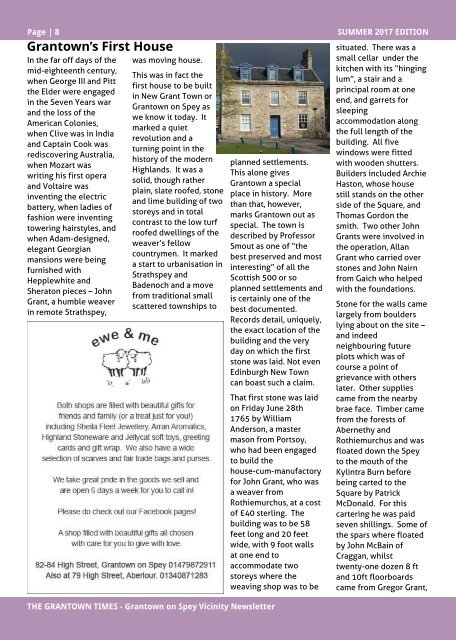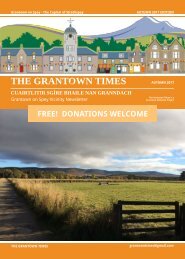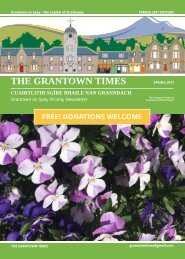GT-summer17
You also want an ePaper? Increase the reach of your titles
YUMPU automatically turns print PDFs into web optimized ePapers that Google loves.
Page | 8<br />
Grant ow n?s First House<br />
In the far off days of the<br />
mid-eighteenth century,<br />
when George III and Pitt<br />
the Elder were engaged<br />
in the Seven Years war<br />
and the loss of the<br />
American Colonies,<br />
when Clive was in India<br />
and Captain Cook was<br />
rediscovering Australia,<br />
when Mozart was<br />
writing his first opera<br />
and Voltaire was<br />
inventing the electric<br />
battery, when ladies of<br />
fashion were inventing<br />
towering hairstyles, and<br />
when Adam-designed,<br />
elegant Georgian<br />
mansions were being<br />
furnished with<br />
Hepplewhite and<br />
Sheraton pieces ? John<br />
Grant, a humble weaver<br />
in remote Strathspey,<br />
was moving house.<br />
This was in fact the<br />
first house to be built<br />
in New Grant Town or<br />
Grantown on Spey as<br />
we know it today. It<br />
marked a quiet<br />
revolution and a<br />
turning point in the<br />
history of the modern<br />
Highlands. It was a<br />
solid, though rather<br />
plain, slate roofed, stone<br />
and lime building of two<br />
storeys and in total<br />
contrast to the low turf<br />
roofed dwellings of the<br />
weaver?s fellow<br />
countrymen. It marked<br />
a start to urbanisation in<br />
Strathspey and<br />
Badenoch and a move<br />
from traditional small<br />
scattered townships to<br />
planned settlements.<br />
This alone gives<br />
Grantown a special<br />
place in history. More<br />
than that, however,<br />
marks Grantown out as<br />
special. The town is<br />
described by Professor<br />
Smout as one of ?the<br />
best preserved and most<br />
interesting? of all the<br />
Scottish 500 or so<br />
planned settlements and<br />
is certainly one of the<br />
best documented.<br />
Records detail, uniquely,<br />
the exact location of the<br />
building and the very<br />
day on which the first<br />
stone was laid. Not even<br />
Edinburgh New Town<br />
can boast such a claim.<br />
That first stone was laid<br />
on Friday June 28th<br />
1765 by William<br />
Anderson, a master<br />
mason from Portsoy,<br />
who had been engaged<br />
to build the<br />
house-cum-manufactory<br />
for John Grant, who was<br />
a weaver from<br />
Rothiemurchus, at a cost<br />
of £40 sterling. The<br />
building was to be 58<br />
feet long and 20 feet<br />
wide, with 9 foot walls<br />
at one end to<br />
accommodate two<br />
storeys where the<br />
weaving shop was to be<br />
SUMMER 2017 EDITION<br />
situated. There was a<br />
small cellar under the<br />
kitchen with its ?hinging<br />
lum?, a stair and a<br />
principal room at one<br />
end, and garrets for<br />
sleeping<br />
accommodation along<br />
the full length of the<br />
building. All five<br />
windows were fitted<br />
with wooden shutters.<br />
Builders included Archie<br />
Haston, whose house<br />
still stands on the other<br />
side of the Square, and<br />
Thomas Gordon the<br />
smith. Two other John<br />
Grants were involved in<br />
the operation, Allan<br />
Grant who carried over<br />
stones and John Nairn<br />
from Gaich who helped<br />
with the foundations.<br />
Stone for the walls came<br />
largely from boulders<br />
lying about on the site ?<br />
and indeed<br />
neighbouring future<br />
plots which was of<br />
course a point of<br />
grievance with others<br />
later. Other supplies<br />
came from the nearby<br />
brae face. Timber came<br />
from the forests of<br />
Abernethy and<br />
Rothiemurchus and was<br />
floated down the Spey<br />
to the mouth of the<br />
Kylintra Burn before<br />
being carted to the<br />
Square by Patrick<br />
McDonald. For this<br />
cartering he was paid<br />
seven shillings. Some of<br />
the spars where floated<br />
by John McBain of<br />
Craggan, whilst<br />
twenty-one dozen 8 ft<br />
and 10ft floorboards<br />
came from Gregor Grant,<br />
THE GRANTOWN TIMES - Grant own on Spey Vicinit y Newslet t er




